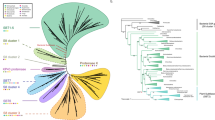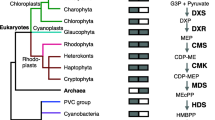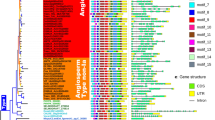Abstract
The nucleotide (p)ppGpp is a second messenger that controls the stringent response in bacteria. The stringent response modifies expression of a large number of genes and metabolic processes and allows bacteria to survive under fluctuating environmental conditions. Recent genome sequencing analyses have revealed that genes responsible for the stringent response are also found in plants. These include (p)ppGpp synthases and hydrolases, RelA/SpoT homologs (RSHs), and the pppGpp-specific phosphatase GppA/Ppx. However, phylogenetic relationship between enzymes involved in bacterial and plant stringent responses is as yet generally unclear. Here, we investigated the origin and evolution of genes involved in the stringent response in plants. Phylogenetic analysis and primary structures of RSH homologs from different plant phyla (including Embryophyta, Charophyta, Chlorophyta, Rhodophyta and Glaucophyta) indicate that RSH gene families were introduced into plant cells by at least two independent lateral gene transfers from the bacterial Deinococcus-Thermus phylum and an unidentified bacterial phylum; alternatively, they were introduced into a proto-plant cell by a lateral gene transfer from the endosymbiotic cyanobacterium followed by gene loss of an ancestral RSH gene in the cyanobacterial linage. Phylogenetic analysis of gppA/ppx families indicated that plant gppA/ppx homologs form an individual cluster in the phylogenetic tree, and show a sister relationship with some bacterial gppA/ppx homologs. Although RSHs contain a plastidial transit peptide at the N terminus, GppA/Ppx homologs do not, suggesting that plant GppA/Ppx homologs function in the cytosol. These results reveal that a proto-plant cell obtained genes for the stringent response by lateral gene transfer events from different bacterial phyla and have utilized them to control metabolism in plastids and the cytosol.





Similar content being viewed by others
References
Adachi J, Hesegawa M (1996) MOLPHY version 2.3: programs for molecular phylogenetics based on maximum likelihood. Comput Sci Monogr 28:1–150
Albi T, Serrano A (2014) Two exopolyphosphatases with distinct molecular architectures and substrate specificities from the thermophilic green-sulfur bacterium Chlorobium tepidum TLS. Microbiology 160:2067–2078
Aravind L, Koonin EV (1998) The HD domain defines a new superfamily of metal-dependent phosphohydrolases. Trends Biochem Sci 23:469–472
Atkinson GC, Tenson T, Hauryliuk V (2011) The RelA/SpoT homolog (RSH) superfamily: distribution and functional evolution of ppGpp synthetases and hydrolases across the tree of life. PLoS One 6:e23479
Brown A, Fernandez IS, Gordiyenko Y, Ramakrishnan V (2016) Ribosome-dependent activation of stringent control. Nature 534:277–280
Cashel M, Gentry DR, Hernandez VJ, Vinella D (1996) The stringent response. In: Neidhardt FC, Curtiss IR, Ingraham JL et al (eds) Escherichia coli and Salmonella: cellular and molecular biology, 2nd edn. ASM Press, Washington DC, pp 1458–1496
Choi MY, Wang Y, Wong LLY et al (2012) The two PPX-GppA homologues from Mycobacterium tuberculosis have distinct biochemical activities. PLoS One 7:e42561
Dalebroux ZD, Swanson MS (2012) ppGpp: magic beyond RNA polymerase. Nat Rev Microbiol 10:203–212
Darriba D, Taboada GL, Doallo R, Posada D (2011) ProtTest 3: fast selection of best-fit models of protein evolution. Bioinformatics 27:1164–1165
Givens RM, Lin M-H, Taylor DJ et al (2004) Inducible expression, enzymatic activity, and origin of higher plant homologues of bacterial RelA/SpoT stress proteins in Nicotiana tabacum. J Biol Chem 279:7495–7504
Gupta RS, Johari V (1998) Signature sequences in diverse proteins provide evidence of a close evolutionary relationship between the Deinococcus-Thermus group and cyanobacteria. J Mol Evol 46:716–720
Hara A, Sy J (1983) Guanosine 5′-triphosphate, 3′-diphosphate 5′-phosphohydrolase. Purification and substrate specificity. J Biol Chem 258:1678–1683
Hauryliuk V, Atkinson GC, Murakami KS et al (2015) Recent functional insights into the role of (p)ppGpp in bacterial physiology. Nat Rev Microbiol 13:298–309
Hogg T, Mechold U, Malke H et al (2004) Conformational antagonism between opposing active sites in a bifunctional RelA/SpoT homolog modulates (p)ppGpp metabolism during the stringent response. Cell 117:57–68
Hori K, Maruyama F, Fujisawa T et al (2014) Klebsormidium flaccidum genome reveals primary factors for plant terrestrial adaptation. Nat Commun 5:3978
Ihara Y, Masuda S (2016) Cytosolic ppGpp accumulation induces retarded plant growth and development. Plant Signal Behav 11:e1132966
Katoh K, Standley DM (2013) MAFFT multiple sequence alignment software version 7: improvements in performance and usability. Mol Biol Evol 30:772–780
Keasling JD, Bertsch L, Kornberg A (1993) Guanosine pentaphosphate phosphohydrolase of Escherichia coli is a long-chain exopolyphosphatase. Proc Natl Acad Sci USA 90:7029–7033
Le SQ, Gascuel O (2008) An improved general amino acid replacement matrix. Mol Biol Evol 25:1307–1320
Loveland AB, Bah E, Madireddy R, et al (2016) Ribosome-RelA structures reveal the mechanism of stringent response activation. Elife 5:e17029
Maekawa M, Honoki R, Ihara Y, et al (2015) Impact of the plastidial stringent response in plant growth and stress responses. Nat Plants 1:15167
Masuda S (2012) The stringent response in phototrophs. In: Najafpour M (ed) Advances in photosynthesis. In Tech, Rijeka, pp 487–500
Masuda S, Mizusawa K, Narisawa T et al (2008) The bacterial stringent response, conserved in chloroplasts, controls plant fertilization. Plant Cell Physiol 49:135–141
Mechold U, Potrykus K, Murphy H et al (2013) Differential regulation by ppGpp versus pppGpp in Escherichia coli. Nucleic Acids Res 41:6175–6189
Mitchell A, Chang H-Y, Daugherty L et al (2014) The InterPro protein families database: the classification resource after 15 years. Nucleic Acids Res 43:D213–D221
Mittenhuber G (2001) Comparative genomics and evolution of genes encoding bacterial (p)ppGpp synthetases/hydrolases (the Rel, RelA and SpoT proteins). J Mol Microbiol Biotechnol 3:585–600
Mizusawa K, Masuda S, Ohta H (2008) Expression profiling of four RelA/SpoT-like proteins, homologues of bacterial stringent factors, in Arabidopsis thaliana. Planta 228:553–562
Potrykus K, Cashel M (2008) (p)ppGpp: still magical? Annu Rev Microbiol 62:35–51
Price DC, Chan CX, Yoon HS et al (2012) Cyanophora paradoxa genome elucidates origin of photosynthesis in algae and plants. Science 335:843–847
Rambaut A, Suchard M, Drummond A (2013) Tracer v1.6. http://tree.bio.ed.ac.uk/software/tracer/. Accessed 14 Mar 2017
Ronquist F, Teslenko M, van der Mark P, et al (2012) MrBayes 3.2: efficient Bayesian phylogenetic inference and model choice across a large model space. Syst Biol 61:539–542
Shimodaira H, Hasegawa M (2001) CONSEL: for assessing the confidence of phylogenetic tree selection. Bioinformatics 17:1246–1247
Stamatakis A (2014) RAxML version 8: A tool for phylogenetic analysis and post-analysis of large phylogenies. Bioinformatics 30:1312–1313
Suzuki K, Miyagishima S (2010) Eukaryotic and eubacterial contributions to the establishment of plastid proteome estimated by large-scale phylogenetic analyses. Mol Biol Evol 27:581–590
Tozawa Y, Nomura Y (2011) Signalling by the global regulatory molecule ppGpp in bacteria and chloroplasts of land plants. Plant Biol (Stuttg) 13:699–709
Tozawa Y, Nozawa A, Kanno T et al (2007) Calcium-activated (p)ppGpp synthetase in chloroplasts of land plants. J Biol Chem 282:35536–35545
van der Biezen EA, Sun J, Coleman MJ, et al (2000) Arabidopsis RelA/SpoT homologs implicate (p)ppGpp in plant signaling. Proc Natl Acad Sci 97:3747–3752
Wendrich TM, Marahiel MA (1997) Cloning and characterization of a relA/spoT homologue from Bacillus subtilis. Mol Microbiol 26:65–79
Acknowledgements
This work was supported in part by JSPS KAKENHI Grant Nos. 16H03280 and 16K14694 to SM.
Author information
Authors and Affiliations
Corresponding author
Electronic supplementary material
Below is the link to the electronic supplementary material.
Rights and permissions
About this article
Cite this article
Ito, D., Ihara, Y., Nishihara, H. et al. Phylogenetic analysis of proteins involved in the stringent response in plant cells. J Plant Res 130, 625–634 (2017). https://doi.org/10.1007/s10265-017-0922-8
Received:
Accepted:
Published:
Issue Date:
DOI: https://doi.org/10.1007/s10265-017-0922-8




